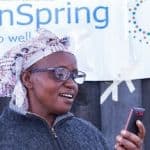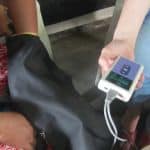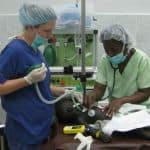Up to 2.5 Billion People Need Glasses: Can This Hardware Innovation Deliver?
This time last year, Shivang Dave and his colleague Aaron Chang were sitting at a table in the District Architecture Center in downtown Washington, D.C., patiently taking questions as they watched a rotating group of engineers, industrial designers, manufacturing and supply chain experts, and journalists tinker with the oversized pair of binoculars they brought with them. Dave and Chang were representing PlenOptika, an affordable medical device startup. The “binoculars” they were presenting at the American Society of Mechanical Engineers (ASME)’s ISHOW hardware competition in D.C. that day were actually a rapid eye screening device that their team had developed to make vision care more affordable and accessible in underserved places.
PlenOptika has had a busy year since then: The company has been working its way through the U.S. and European regulatory approval processes for its device, which is called the QuickSee. The team expects to clear final approval in the coming months. It also officially began selling the QuickSee in India in February. “It’s been really well received,” says Dave, who serves as PlenOptika’s CEO. “People like that it’s fast and easy, and accurate.”
Those milestones have been a long time in the making for PlenOptika’s team, which got its start in 2011. The founding team, which includes Dave, Nicholas Durr, Daryl Lim and Eduardo Lage, met as engineering postdoctoral fellows at the Madrid-MIT M+Visión Consortium. The program was a five-year partnership between the government of Madrid and MIT, with a mission to build entrepreneurial activity around underserved global health needs. The newly formed team discovered that glasses were one of those needs.
The world’s blurry vision
Roughly 4.5 billion people worldwide need vision correction, according to a report by the World Economic Forum and EYElliance. Of those, somewhere between 1.1 and 2.5 billion need glasses but don’t have them. That’s about 25 percent of the global population, many of whom have likely never even had an eye exam. Through the M+Visión fellowship, PlenOptika’s founding team members began investigating why.
“The most common assumption is that glasses are expensive in places like the U.S. and Europe, so they must be expensive everywhere,” Dave explains. But in India and other emerging markets, low-cost eyeglasses priced at $2 and $4 each are readily available. What aren’t available are trained eye care specialists. India has approximately the same number of optometrists as the U.S. – and almost 4000 fewer ophthalmologists – serving a population that exceeds America’s by over 1 billion.
“In many countries, there just aren’t enough eye care professionals,” he says. The PlenOptika team knew they couldn’t meet this global need for vision care by exponentially multiplying the number of eye care specialists out there. But through M+Visión, they were encouraged to develop a technical solution that could help.
The team’s solution was the QuickSee, a binocular-sized autorefractor that can scan a patient’s eyes within a few seconds and produce a close approximation of the eyeglass prescription a patient might need. It doesn’t aim to replace optometrists, particularly because it cannot diagnose eye diseases like glaucoma or macular degeneration. But it simplifies vision screening tests enough to enable general clinical workers and healthcare providers to serve patients who don’t have access to a specialist.
Pricing for PlenOptika’s basic QuickSee model starts at a couple thousand dollars—far below the price point of most standard autorefractors, which sell for $10,000 or more. The team believes the QuickSee’s potential market includes all eye doctors and vision centers in emerging and advanced markets alike, as well as other social enterprises and non-profit organizations providing healthcare services to low-income and underserved patients.
“We know there’s a global market for glasses, so our market includes any place where glasses are made and sold,” says Dave, adding that because PlenOptika’s technology enables capacity building, it could also help expand the market to places that are currently underserved.
The long road to market
Conducting extensive market research was one of the requirements of M+Visión. “The program really stressed the importance of taking a market-based approach. They didn’t want us building solutions for which there was a need but no demand,” Dave says.
Understanding the market and accessing it are two very different things, however. Unlike a software-based app which can take mere months to launch, a piece of hardware like the QuickSee requires years of design, prototyping, testing and refinement. What’s more, because it is used in healthcare, the QuickSee requires regulatory approval—a tedious, complicated and costly process for any organization to go through, but particularly for a lean startup trying to build an affordable product.
PlenOptika committed four full-time engineers, a part-time regulatory consultant and 25 percent of its executive team’s time to the approval process for four months last year. Since then, the team has put the QuickSee through more than 30 hours of electromagnetic compatibility and electrical safety testing; built sample devices to test and re-test the QuickSee’s electronics and safety features; and conducted extensive research to ensure that the latest batch of devices it sent off for regulatory testing would pass.
“It has been a huge amount of work, and it is still not finished,” says Lage, who has been leading the regulatory testing and compliance efforts for the QuickSee. “Regulations for medical devices are very complicated and it is [often] very difficult to obtain clear answers, even from consultants. Knowing what has to be done and in which way has been a real challenge.”
Lage says the team expects to be approved by both the U.S. and European regulatory bodies in the coming months. (Such certifications are not required in India, though PlenOptika’s team acknowledges that the U.S. and European certifications will give the product greater legitimacy there as well.) He offers the following advice to other organizations facing (and perhaps procrastinating on) similar regulatory approval processes: “The sooner you start to take care of this, the better the time to market will be.”
An essential ecosystem
PlenOptika’s team is so often caught up in the minutiae of building a functional and compliant piece of hardware that they relish moments that remind them of why they have been working so diligently, and with such scant resources, for the past seven years.
“It often feels like you’re doing this alone, particularly when you’re worrying over how your startup is going to pay its bills, or you’re struggling to find information and answers to questions. It can be exasperating,” Dave says. “But when you go into the field and see your work in action, or get emails from people all over the world asking about the product you made, you’re reminded that all your efforts have been addressing a need that is going to help people, and that there is market interest in the work you’ve done.”
Dave and the rest of the PlenOptika team also credit the small but committed ecosystem supporting social hardware startups for its pivotal role in helping PlenOptika get this far. The team has received critical financial support from M+Visión, the International Agency for Prevention of Blindness, the U.S.–India Science and Technology Endowment Fund, the NIH, ASME’s ISHOW, and several angel investors. PlenOptika has also relied on a network of formal and informal mentors and advisors from its funders, as well as the MIT Venture Mentoring Service, TiE ScaleUp, the Harvard Launch Lab and Johns Hopkins University.
“The world is so dominated by apps right now. When you’re trying to navigate your way in hardware, it really makes a difference having a community of people who understand and care about hardware,” says Dave. “We’ve been lucky that we’ve been able to find the resources we need when we need them. Whether that’s having a contact pick up the phone to make connections on your behalf, or answering questions about standards, or cutting a check at the right time—whether you have those resources is what will make or break you in this field.”
PlenOptika still has hurdles to overcome. It has recently started mass manufacturing, and now has to focus on building sales and distribution partnerships to deploy its technology worldwide. But as Dave puts it, the path forward looks remarkably clearer.
Demand’s full case study on PlenOptika is available here.
Paul Scott is the director of engineering for global development at ASME. He heads ASME’s Innovation Showcase (ISHOW) for hardware startups, at which PlenOptika was a winner in 2017.
Jessica Pothering, a journalist and editor of ASME’s Demand magazine, contributed reporting for this article.
Main photo courtesy of PlenOptika.
Homepage photo credit: J P Davidson, via Flickr.
- Categories
- Health Care, Social Enterprise, Technology
- Tags
- partnerships



